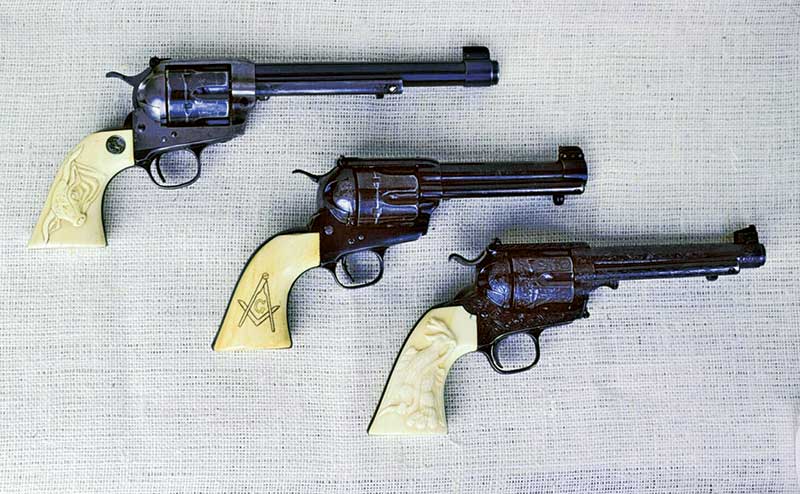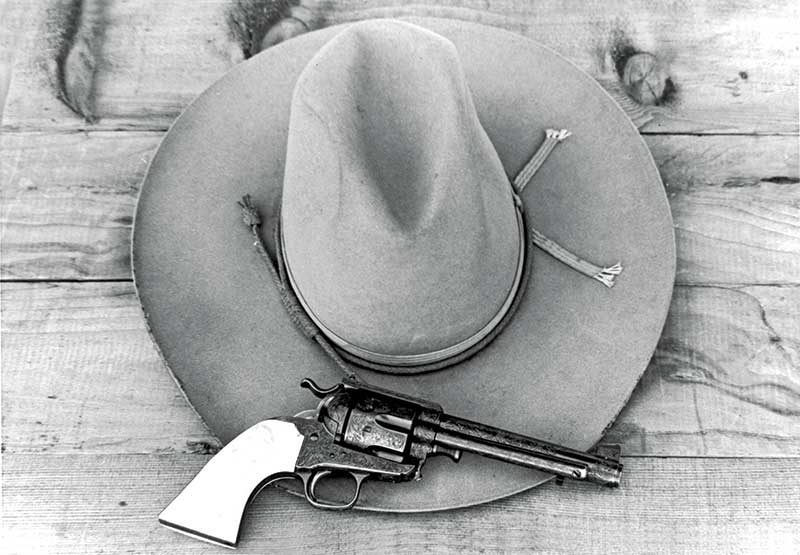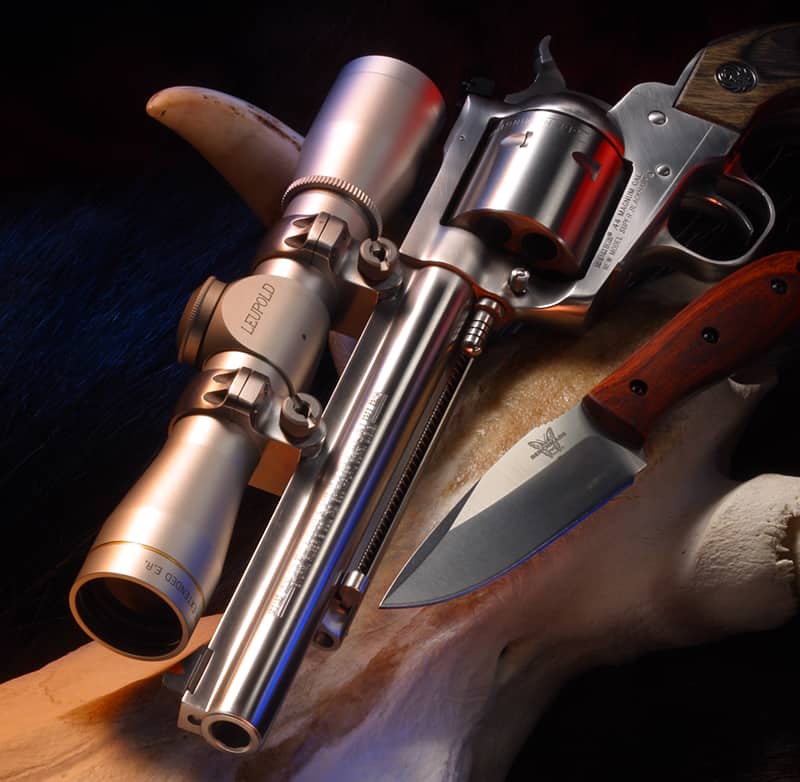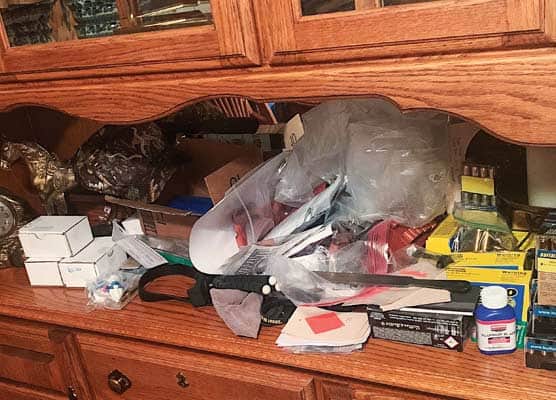The Legend Lives!
Lipsey’s delivers again.
For a quarter-century beginning in the mid-1950s the Sixgunners Mecca was found in the little town of Salmon, Idaho, where Elmer Keith resided. This ended when he suffered a stroke in 1981, as he would spend the next three years in a Boise, Idaho, nursing home. From the time of his passing until a few years ago, everything was kind of in limbo. Then Cabela’s incorporated the Elmer Keith Museum within their Boise store, and now sixgunners come from all over to view the sixguns, rifles and hunting trophies of Elmer Keith.
I was given the rare privilege of placing all the firearms, and so was able to position the No. 5 S.A. in the spot where it could be seen immediately as you enter the museum. It is the centerpiece of the sixgun display. I “visit” the No. 5 at least once a month.
From the late 1920s until 1955, Keith continually promoted the .44 Special as the ideal sixgun cartridge using his designed “Keith” bullet, weighing 250 grains and pushed at a full 1,200 fps using first No. 80 powder and then, when it became available, Hercules No. 2400. Over the years Keith featured his sixguns in his articles, and as a teenager I purchased a copy of Sixguns By Keith, subsequently spending many hours carefully studying the pictures of his many custom sixguns. Other teenagers were interested in the new rock and roll music, movies and fast cars. I soon lost interest in all three but developed a passion for sixguns.
The Four Colts
Keith was not satisfied with stock factory sixguns and enlisted the help of some of the top gunsmiths and engravers in the country to customize his sixguns. His four Colt Single Action .44 Specials were a King short-action job with a 7-1/2″ barrel, an original one-of-a-kind 7-1/2″ Flat-Top Target, a 5-1/2″ Flat-Top Target with a folding 3-leaf rear sight designed by Keith and the No. 5 S.A. Colt—an extensively customized 5-1/2″ Flat-Top Target Model with a special grip made by combining a Bisley backstrap and Colt SAA triggerguard.
This now famous custom Colt was written up as “The Last Word” in the April 1929 issue of the American Rifleman. The title for the article comes from the fact this revolver was designed as the epitome of the single-action sixgun. Every possible improvement was incorporated in “The Last Word” sixgun and Keith tried to interest Colt in making it a factory offered single action, but to no avail.
Keith, along with the ideas of Harold Croft and gunsmiths Neal Houchins, R.F. Sedgley and J.D. O’Meara, worked together to weld up the top strap of a standard Colt Single Action to make a heavy Flat-Top Target design. The old flat mainspring was replaced by a U-type spring, and the hammer was made by welding a Bisley wide spur on a standard hammer. The rear sight is adjustable and the front sight is the high Patridge type. The base pin latch was changed to eliminate any chance of the pin jumping forward under recoil, and mating a standard Colt SAA triggerguard with a Bisley backstrap made the grip frame.
Croft Connection
In the late 1920s, Harold Croft of Pennsylvania had packed a suitcase full of sixguns and took the train all the way across the country to Elmer Keith’s small ranch in Durkee, Ore. At the time Croft was having lightweight pocket pistols built on Single Action and Bisley platforms, while Keith was more interested in full-sized single actions for long-range shooting and everyday packing. Gunsmiths Sedgley and Houchins had turned Croft’s ideas for perfect sixguns into reality, with the former doing all the framework and the latter working on the sights, stocks and action. The frames were also flat-topped and fitted with adjustable sights. All of the Croft Featherweights weighed between 30 and 32 ounces, and were written about by Keith in the American Rifleman in 1928.
One year after the Croft visit, Keith unveiled his idea of the perfect sixgun in the above-mentioned article, “The Last Word.” He incorporated many of Croft’s ideas including the flat-topped frame, adjustable sights and the modified grip frame. Keith called his new sixgun the No. 5 S.A., as it had been patterned after Croft’s numbers M1 to M4. When Croft visited Keith, his sixguns numbers M1 to M4, were .45s, while Keith’s No. 5 was a .44 Special. Of the two Croft sixguns that have surfaced lately, both have been converted from .45 Colt to .44 Special. Both sixguns have two dates on them and I am assuming one date is for the original completion to .45 Colt, and the other represents the changeover to .44 Special by Croft.
In the mid-1980s, Bill Grover of Texas Longhorn Arms built his salute to Elmer Keith with his Improved Number Five. Grover’s single actions were all mirror images of traditional single actions, that is, the loading gate and ejector rod were on the left side instead of the right side. Bill maintained this was natural for use by a right-handed person.
Grover said Keith chose what was the best cartridge when he built his No. 5 S.A., then namely the .44 Special. In the 1980s, Grover chose what he considered the best cartridge of the time, the .44 Magnum. Texas Longhorn Arms and the Improved Number Five were relatively short-lived, and the factory closed its doors before the turn of the century.
In the early years of the new century, I had talked with the then president of Ruger about bringing out a .44 Special; he didn’t say yes, but he didn’t say no. When the .357 Blackhawk arrived in 1955, the next step should have been the same sixgun chambered in .44 Special. When the .44 Magnum was introduced in late 1955, all thoughts of a .44 Special were lost, and in early 1956 a larger Blackhawk was introduced in the new .44 Magnum instead.
By 1972, all Rugers, .30 Carbine, .357 Magnum, .41 Magnum, .44 Magnum and .45 Colt were built on the same large-size New Model frame. Fast-forward 50 years. When Ruger came out with the Anniversary Model .357 Flat-Top in 2005, it was not on the old 3-Screw action, which allowed only five rounds to be carried safely, but rather on the New Model transfer bar action, and the safe carrying of a full six rounds. It was, however, the same size as the original Blackhawk of 1955. The original version from 50 years ago never made it to a .44 Special, however this one now seemed to me to be a natural for chambering in .44 Special. Jason Cloessner of Lipsey’s also thought so. The .357 Magnum Flat-Top Blackhawk Anniversary Model was chambered in .44 Special and offered by Lipsey’s, a major distributor to the firearms trade, in both 4-5/8″ and 5-1/2″ versions.
Ruger liked the idea so well, finally, that after the run of special Lipsey’s Specials, the New Model Flat-Top .44 Special became a standard catalog item. So what would be next for Lipsey’s? The blue versions had sold well, so now the next natural step would be a stainless steel .44 Special Flat-Top. I liked mine so well it was fully engraved by Michael Gouse even before I shot it. When I got it back and actually fired the first rounds, I was not disappointed as it is capable of 1-hole groups. Mine has now not only been engraved, it also wears ivory grips.
Jason thanked me for being the inspiration for resurrecting the .44 Special, and now Lipsey’s is offering what is definitely a direct inspiration from Keith’s No. 5 S.A. No, it is not called a No. 5, but it is a .44 Special with a Flat-Top frame, adjustable sights, wide hammer and 5-1/2″ barrel. Keith’s original No. 5 grip frame was made by blending the backstrap of a Bisley and the triggerguard of a Single Action; Lipsey’s “No. 5” uses the Ruger Bisley Model grip frame which fits most sixgunner’s hands much better than the smallish Keith-style.
I have fired the Texas Longhorn Arms Improved Number Five extensively in both .44 Magnum and .45 Colt, and I find the grip which was made to precisely fit Keith’s hand is very unforgiving in my hand. I have to concentrate mightily to maintain the same exact grip each time, or groups will open up. The Bisley Model grip frame from Ruger is much more forgiving and also allows room for my whole hand. I know felt recoil is quite subjective, but at least in my hand it is also just about the best factory single-action grip for reducing felt recoil.
Keith’s No. 5 was fully engraved and ivory-stocked. The Lipsey’s version is standard blue. However, mine shoots so well, groups of 7/8″ and 1″ are not uncommon, it is going to be carried farther down the path of the No. 5. That means full engraving, carved ivory grips with a Mexican eagle and refinished with a case hardened frame and hammer by Turnbull Manufacturing.
Lipsey’s
P.O. Box 83280, Baton Rouge, LA 70884
www.lipseys.com






